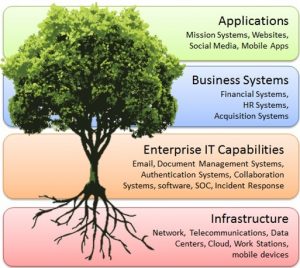The thinking seems to be that if we need to save money, we need to drive efficiency from these common capabilities. The problem is that our budgeting process doesn’t help us to do that. Our budgeting process helps us to see what is big and what is small.
I like to think about budgeting for IT like a tree. We have certain capabilities that make up the roots and trunk of the tree and we have higher level capabilities that comprise the branches and eventually the leaves and flowers of a tree.
 The reason this approach for budgeting for IT will work better is because the information we collect about infrastructure capabilities should be different from the information we collect about enterprise IT capabilities, business systems, and applications. Today, we just have one big pot, “major” and then we try to make it fit all the different disciplines. This creates a situation in which we are submitting onerous and useless information that isn’t helpful in evaluating whether an investment is on track. Additionally, because of this one-size-fits all approach, we don’t have a good handle on comparing similar types of investments across agencies.
The reason this approach for budgeting for IT will work better is because the information we collect about infrastructure capabilities should be different from the information we collect about enterprise IT capabilities, business systems, and applications. Today, we just have one big pot, “major” and then we try to make it fit all the different disciplines. This creates a situation in which we are submitting onerous and useless information that isn’t helpful in evaluating whether an investment is on track. Additionally, because of this one-size-fits all approach, we don’t have a good handle on comparing similar types of investments across agencies.
This approach also leads to all those data calls from OMB. Those data calls come down because someone up there wants to compare the performance of, let’s say, data centers, across agencies. We don’t do a good job of capturing the detailed budget information and performance information in the CPIC business case process. So OMB is forced to come up with a discrete data call that delivers that information.
If you have read a few of my chapters you know that I have affection for golden rules. God only needs one, but I apparently need a whole bunch. My golden rule here is that reoccurring data collection exercises in the Integrated Data Collection (IDC) should find their way to the normal flow in what I would call a Budget and Performance Package. The way we are doing it now is haphazard and chaotic. In the budget submission we get the budget request but we lack the important performance information. In the IDC we get the valuable performance information but we lack the budget details.
Nobody can be effective in analyzing and telling a story without the connection between the budget data and the performance data. But look at the Federal Data Center Consolidation Initiative (FDCCI) data3 and try to marry that up with the IT budget data 4. You just have to trust me when I say that these two data sets bear no relation to each other. But they should, and that is my point.
Naysayers will say that you can’t integrate something like the FDCCI data (which, by the way is evolving to be the Data Center Optimization Initiative in the draft memo5) with the budget data. They will say that we only submit budget data once per year, but the FDCCI data was updated quarterly. That is wrong. It is true that the budget can only be changed once (actually twice, once for budget submission and once more post passback). But agencies should be reporting performance information on a monthly basis for their investments.
Thus if you look at the draft DCOI memo, you can see the data elements that are to be captured that reflect revised FDCCI data. Then if you simply append budget request columns onto that data, guess what? You have successfully married budget data to performance data. The performance data must be updated quarterly and the budget data annually.

